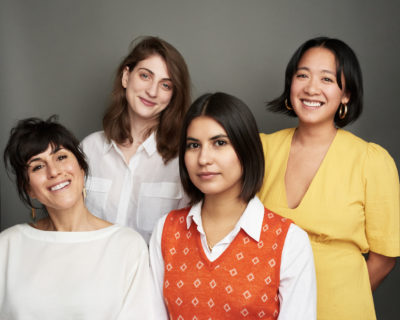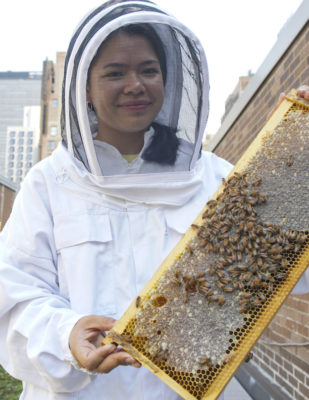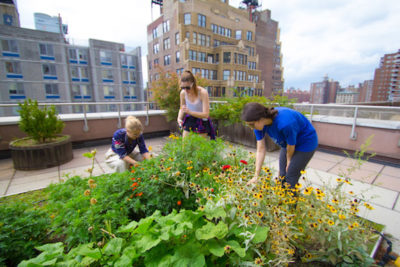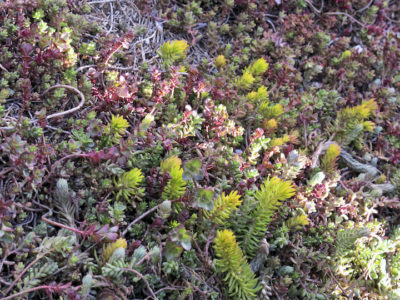Sustainability Awareness Week, October 5 to 9, is a chance to take stock of past achievements in sustainability and plan to take further action. Here are seven earth-friendly programs taken on by students, alumni, faculty, staff, and administrators. They are all pieces in a broader effort to help make the campus more sustainable, educate our community and industry on best practices, and innovate for a greener future.
Read on to learn about these recent successes and other sustainability-focused programs at FIT.
1. Finding Inspiration in Nature

Werewool, a team of Textile Development and Marketing students and recent graduates, as well as Theanne Schiros, assistant professor of Science, won a 2020 Global Change Award, a sustainable innovation challenge initiated by the H&M Foundation. The team of Morgana Kattermann, Valentina Gomez, Chui-Lian Lee, and Schiros was selected for one of five awards out of 5,893 entries from 175 countries. Werewool was awarded 250,000 euros and admission to a yearlong accelerator program. They are also one of nine finalists for the $100,000 Ray of Hope Prize from the Biomimicry Institute, chosen from 190 applications from 42 countries.
Werewool is developing biodegradable fibers with aesthetic and performance properties inspired by organisms in nature. Using the tools of biotechnology, they engineer structural proteins with color, moisture management, and stretch, thereby avoiding toxic dyeing and coating processes, to create low-impact textile fibers with a circular life cycle.
Werewool is one of many projects that have emerged from FIT’s participation in the Biodesign Challenge, a global undergraduate biotechnology competition now in its fifth year. Another alumni team, Algiknit, which is developing a fiber from kelp, won the challenge in 2016, have won multiple major awards, and in 2018 received $2.2 million in seed funding.
2. Creating Circularity with Muslin
Cotton muslin is used in every Fashion Design classroom, and about a third of it goes to waste. And growing new cotton, an extremely water-intensive crop, exacerbates water scarcity worldwide. “Waste to Resource: Green chemistry degradation of cotton waste for circular economy textiles” is a research collaboration between FIT and Stony Brook University, both SUNY campuses, to develop a nontoxic process that recycles muslin into raw cellulose.
The project has been awarded part of a $300,000 grant from the National Science Foundation’s Environmental Sustainability program. (Stony Brook University is the lead institution on the grant.) The principal investigators are Theanne Schiros and Asta Skocir, associate professor of Fashion Design (both of whom are co-founding advisors to Algiknit), along with Gary Halada and Taejin Kim in the Materials Science and Chemical Engineering Department at Stony Brook. The project involves student-led research to promote circularity in the fashion industry.
3. Composting in the Residence Halls
FIT students have moved home, but that doesn’t diminish the achievement of three students who worked with New York’s Department of Sanitation to bring a composting program to the residence halls. Composting keeps food scraps out of landfills and converts them into an organic material that improves soil. Learn more in this one-minute video:
4. Rooftop Beehives

After presenting their idea at the Clinton Global Initiative University (CGI U), a team of students installed beehives on an FIT roof. The Honeybee Conservancy, a nonprofit that supports bee populations, has helped maintain them. This spring, two new hives are being installed, and two students (Michele Sparrow, Textile Development and Marketing, and Sydney Wilson, Production Management) have begun a new CGI U project to raise awareness of the hives, expand honeybee education, and offer more volunteer opportunities.
FIT’s hives have become part of a “pollinator corridor” that includes Madison Square Park, the Flower District, and the High Line, plant-rich areas that offer good foraging areas for bees. The FIT Hives project contributes to the effort to support the bee population in New York City, and serves as an educational tool, as well. Each year, students harvest the honey, which has been bottled and also used in an FIT-branded lip balm.
5. Natural Dye Garden

Thanks to the efforts of a team of students, who presented at CGIU, FIT installed a natural dye garden on the ninth floor in 2014. Since then, students have maintained the garden, and the Textile Development and Marketing Department has used it as an educational tool, to demonstrate an alternative to toxic synthetic dyes.
The natural dye education program also takes place on retired Professor Jeffrey Silberman’s farm upstate, as students grow and harvest indigo and coreopsis to use as fabric dye. This farm project has been supported by grants from FIT’s Sustainability Council.
6. An Award-Winning Campus Energy Reduction Program
FIT has been so successful at reducing its carbon footprint since 2007 that it has become a model for other institutions in New York City and beyond. In 2007, then-mayor Michael Bloomberg challenged New York City colleges and hospitals to reduce their greenhouse gas emissions by 30 percent by 2030. FIT was the first to succeed, with a 40 percent reduction in less than four years. President Joyce F. Brown, along with leaders of 12 other institutions, then pledged to reduce the college’s carbon footprint by 50 percent by 2025. FIT was first again, with a 55 percent reduction by 2018, seven years ahead of schedule. Most of the energy reduction resulted from new steam-powered heating, cooling, and ventilation systems, which are much more efficient than electrical turbines. LED lighting with occupancy sensors also made a significant impact.
7. Green Roofs

From the street level, FIT’s imposing brutalist buildings are a signature of New York City’s urban landscape. Look at FIT from above, and a greener picture emerges. Nearly an acre of green roofs, made up of hardy succulents in the genus Sedum, offer numerous environmental benefits. They insulate the buildings, improve air quality, help cool the neighborhood, and absorb rainfall, mitigating flooding in the city’s sewers during storms. Also, atop the Shirley Goodman Resource Center, solar panels provide electricity for the grid.
